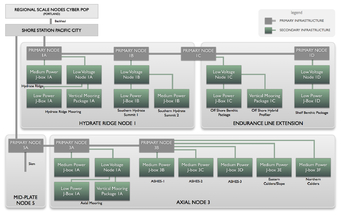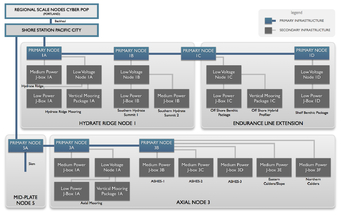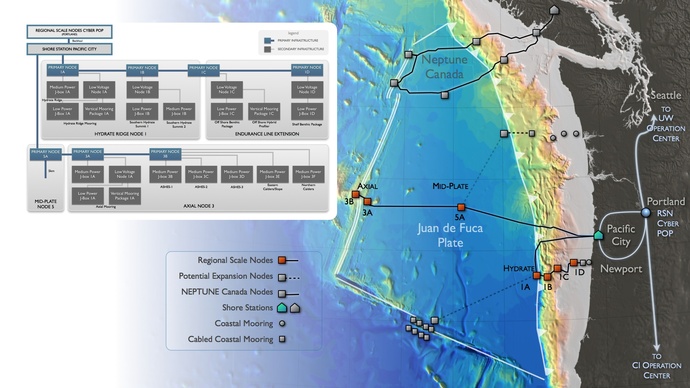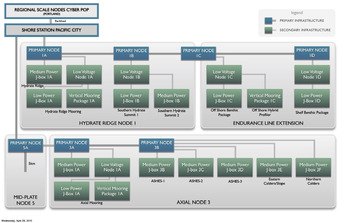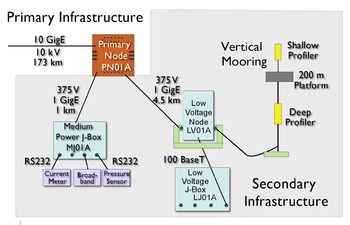The Primary Infrastructure is a major component of the RSN. It distributes power and communication from the land-based Shore Station in Oregon to sub-sea terminals at depths of up to ~3000 meters across the Juan de Fuca Plate. These sub-sea terminals called Primary Nodes have connection points for instrument platforms and their interconnection infrastructure to allow continuous, real-time interactive science experiments at the seafloor. The Primary Infrastructure will also include equipment used in the sub-sea telecommunications industry to capitalize on the high reliability needed to provide a system life of 25 years. A 2007 white paper describes the RSN Wet Plant Primary Infrastructure.
The Primary Infrastructure subsystem of the RSN starts with the Backhaul System that provides Internet connectivity from a CyperPOP in Portland Oregon, to the Pacific City Shore Station. Required infrastructure within the Shore Station is part of the RSN Primary Infrastructure, but the physical Shore Station facility is not part of this subsystem. The Primary Infrastructure includes power feed equipment (PFE) to convert utility power to regulated and controlled high voltage (10 kV) power for each of the sub-sea cables that terminate in that Shore Station. The Primary Infrastructure also includes the subsea line termination equipment (SLTE), which has the optical drivers and receivers for the sub-sea cables that terminate in the Shore Station and the electronics to convert the optical signals to network connections suitable for connecting to IP based interfaces.
The Primary Infrastructure includes the cable landing that provides a transition for the sub-sea cable from the ocean bed through conduits to the Shore Station. It includes the cable needed to reach all of the sub-sea terminals including any needed Repeaters to reach the required distance. Finally the Primary Infrastructure includes the sub-sea terminals called Primary Nodes that convert the High Cable Line Power Voltage (10 kV) to a lower (375 V) level and distributes it to science ports along with communications and timing signals. These science ports are the connection to the Secondary Infrastructure and Instrument Platforms.
The entire Primary Infrastructure is monitored and controlled by a Network Management System (NMS). This system allows both the communication and power systems to be monitored for activity, status, utilization and to control allocations of resources across the system. The NMS can be accessed from the Shore Station or from remote facilities including the RSN Operations Center. The current Project Execution Plan calls for the entire Primary Infrastructure to be designed and implemented by a single Contractor. Having one contractor responsible for the Primary Infrastructure will reduce the number of interfaces that must be controlled between various parties and will reduce the overall risk of this critical and expensive part of the OOI.
